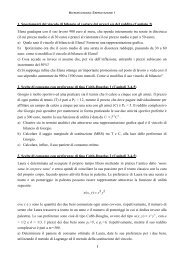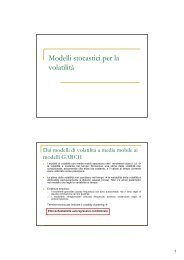Teoria della selezione del portafoglio e modelli di equilibrio del ...
Teoria della selezione del portafoglio e modelli di equilibrio del ...
Teoria della selezione del portafoglio e modelli di equilibrio del ...
You also want an ePaper? Increase the reach of your titles
YUMPU automatically turns print PDFs into web optimized ePapers that Google loves.
3.2.2 Caso <strong>di</strong> titoli o business con ren<strong>di</strong>menti aleatori linearmente correlati<br />
E’ il caso <strong>di</strong> rilevante interesse operativo, in quanto rappresenta la “totalità” <strong>del</strong>le realtà<br />
sia produttive che finanziarie.<br />
Riprendendo l’equazione <strong><strong>del</strong>la</strong> varianza ed equiripartendo il capitale tra gli n titoli o<br />
business si ha una varianza <strong>di</strong> <strong>portafoglio</strong> o aziendale pari a 34:<br />
2 2 2<br />
σ = ( 1/ n) σ + ( 1/ n)( 1/<br />
n)<br />
σ<br />
P<br />
n<br />
∑ ∑<br />
n<br />
∑<br />
1i≠j i ij<br />
i=<br />
1<br />
i=<br />
j=<br />
1<br />
Raccogliendo:<br />
- 1/n nel primo addendo;<br />
- (n-1)/n nel secondo addendo, dopo aver moltiplicato e <strong>di</strong>viso per (n-1);<br />
si ottiene<br />
n 2<br />
n n<br />
σ<br />
σ<br />
2 ⎡ ⎤ i n −1<br />
⎡ ij ⎤<br />
σ P = 1 / n⎢∑<br />
i 1 n<br />
⎥ + ∑∑ ⎣ ⎦ n<br />
⎢<br />
i 1 j n n<br />
i j 1 ⎣ −1<br />
⎥<br />
= = ≠ = ( ) ⎦<br />
Entrambi i termini entro parentesi quadre rappresentano me<strong>di</strong>e:<br />
2<br />
- il primo, come già detto, è la varianza me<strong>di</strong>a dei titoli o business in <strong>portafoglio</strong>, σi ;<br />
- il secondo è la covarianza me<strong>di</strong>a dei titoli in <strong>portafoglio</strong>, σij (le covarianze sono in<br />
numero <strong>di</strong> n(n-1)).<br />
Allora, l'equazione precedente può essere riscritta come<br />
2 2<br />
σ = ( 1/ n) σ + ( n −1)/<br />
n σ<br />
32<br />
n<br />
[ ]<br />
P i ij<br />
Essa permette <strong>di</strong> verificare che per n che tende ad infinito:<br />
- il primo addendo tende a zero;<br />
- il secondo addendo tende al valore asintotico σij, che non può essere annullato (vedasi la<br />
Fig.13). Quin<strong>di</strong><br />
n<br />
lim P = lim +<br />
n→∞<br />
n→∞<br />
n n<br />
−<br />
2 ⎡1<br />
2 1 ⎤<br />
2<br />
σ<br />
⎣<br />
⎢<br />
σ σ<br />
⎦<br />
⎥<br />
= σ = σ σ ρ = σ ρ<br />
i ij ij i j ij i ij<br />
34 Utilizzando i cinque titoli o business A, B, C, D, E, ed i dati in Tab. 3, matrice simmetrica <strong>del</strong>le varianze e<br />
covarianze tra i ren<strong>di</strong>menti <strong>del</strong>le cinque possibilità, si calcoli il rischio <strong>di</strong> <strong>portafoglio</strong> nell'ipotesi <strong>di</strong><br />
x i = 1/ 5,<br />
∀i<br />
(Arrotondamenti alla seconda cifra decimale).<br />
2<br />
5<br />
2 ⎛ 1 5 5<br />
2 1 1<br />
σP= ⎜ σi σ<br />
⎝ 5<br />
5 5<br />
⎞ ⎛<br />
∑ ⎟ + ⎜<br />
⎠ ⎝<br />
⎞<br />
⎟<br />
⎠<br />
⎛<br />
⎜<br />
⎝<br />
⎞<br />
∑ ∑ ⎟<br />
⎠<br />
i=<br />
1<br />
i=<br />
1j=<br />
1<br />
ij<br />
2<br />
σ<br />
σ<br />
2 1 5<br />
i 5 1 5 5<br />
ij<br />
σ P = ∑<br />
5 i 1 5 5 i 1j<br />
15(<br />
5 1)<br />
1 2 4 286 343 114 4 0 43 2 29 014 0 29 0 29 114 114 0 71 0 57 014<br />
2<br />
5<br />
5<br />
5<br />
20<br />
1<br />
4<br />
269 2 02 086<br />
5<br />
5<br />
⎡ ⎤ −<br />
⎢ ⎥ + ∑ ∑ =<br />
⎣⎢<br />
= ⎦⎥<br />
= = −<br />
⎛ + + . + . + . ⎞ ⎛ − . + . + . − . − . + . + . + . − . + . ⎞<br />
= ⎜<br />
⎟ + × ⎜<br />
⎟ =<br />
⎝<br />
⎠ ⎝<br />
⎠<br />
= × . + × × . = .
















